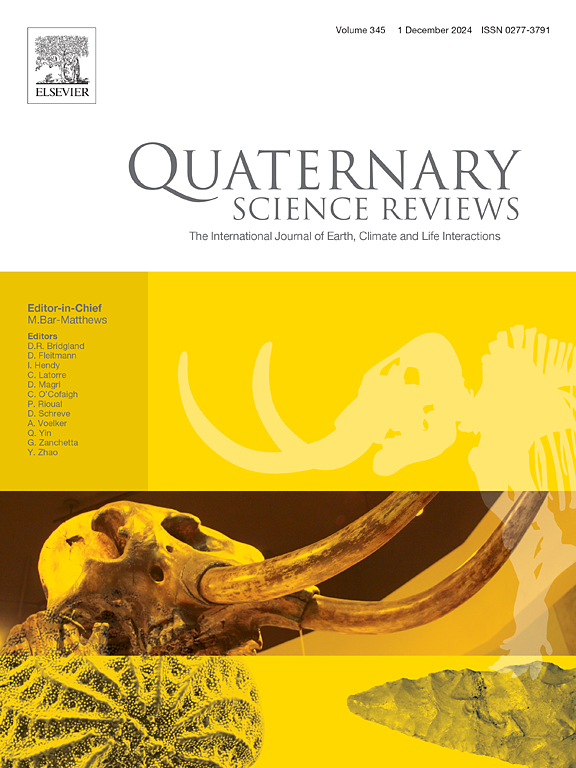Ría de Vigo(伊比利亚西北部)全新世海洋变迁期间的沉积物循环:多代理证据和环境影响
IF 3.2
1区 地球科学
Q1 GEOGRAPHY, PHYSICAL
引用次数: 0
摘要
本文介绍了对位于 Ría de Vigo(伊比利亚西北部)的 155 厘米沉积物岩芯进行的一项新的多代研究,该岩芯记录了全新世海平面上升过程中的跃进和高台系统道。介绍的新数据包括粒度、地球化学分析、高分辨率花粉、非花粉古生物和甲藻孢囊含量的定性/定量分析、不同关键层硅藻的定性评估以及对一些地震解释的重新考虑。此外,还从贝壳和花粉提取物中获得了 14 个放射性碳年代。这些新证据表明,全新世期间,沉积速率和不同类型古动物的相对丰度发生了显著变化。所研究的沉积物岩芯显示了早全新世和中全新世期间的异常花粉演替,包括意想不到的松树花粉高峰。差异年代测定显示,这些异常演替与花粉年代倒置的明显老化沉积物相对应。因此,这些地层可能是古代高地沉积物重新沉积的证据,这些沉积物是在末次冰川极盛期末期和大冰川早期之间的不同时期在古代海岸线上方形成的,其中富含抗性很强的花粉类型(松树)。双鞭毛虫孢囊记录与非重整花粉证据相结合,揭示了全新世期间可靠的气候跷跷板,包括盛行混合水域的潮湿风暴期,Lingulodinium 大量繁殖,双鞭毛虫孢囊的积累率很高;与之交替的是其他稀疏风暴期和干燥期,其特点是沿岸上升流加强,水域分层良好,Bitectatodinium 和 Spiniferites spp.增加,但双鞭毛虫孢囊的积累率较低。但甲藻孢囊的积累率较低。这些气候动态,包括热最适期之后出现的千年干旱凉爽期,与之前在伊比利亚半岛其他湖泊系统中获得的证据一致。此外,海洋对沉积物贡献最大的两个阶段(约公元前 11.0-8.2 年和约公元前 4.0-3.0 年)与随后相对海平面趋于稳定的温暖阶段(分别为热最适期(公元前 8.0-6.0 年)和公元前 2.5-0.5 年)之间存在延迟。冰期后沉积物中记录的松树花粉浓度和粒径的变化表明,一些高地古(冰期)花粉证据可能被重新移动,特别是在上升流加强的阶段,然后重新沉积在海底。要确定松树花粉粒径之间存在的显著差异是与影响该地区的气候变异有关,还是该地区松树物种更替的结果,还需要进一步的研究。尽管如此,松树花粉证据几乎随着该地区人类活动的最初迹象而消失,直到现代人口重新聚居后才得以恢复。我们的发现为我们进一步了解沉积物再加工和再循环机制提供了新的可能性,即通过整合包括花粉、地震和沉积数据在内的多代理研究。本文章由计算机程序翻译,如有差异,请以英文原文为准。
Sediment recycling during the Holocene marine transgression in Ría de Vigo (NW Iberia): multiproxy evidence and environmental implications
A new multiproxy study of a 155-cm sediment core located in Ría de Vigo (NW Iberia) recording the transgressive and highstand system tract of the Holocene sea-level rise is presented. New data described include grain size, geochemical analyses, high-resolution qualitative/quantitative analyses of pollen, non-pollen palynomorphs and dinoflagellate cysts content, the qualitative evaluation of diatoms at different key levels and the reconsideration of some seismic interpretations. Besides, 14 radiocarbon dates were obtained from shells and pollen extracts. This new evidence revealed that notable changes in the sedimentation rates and the relative abundance of the different types of palynomorphs occurred during the Holocene. The sediment core studied shows anomalous pollen successions, including unexpected Pinus pollen peaks, during the Early and Middle-Holocene. Differential dating revealed that those anomalous successions correspond to conspicuously aged sediment that has inverted pollen chronologies. Thus, these facies may constitute evidence of redeposition of ancient upland sediments, formed above the ancient coastline at different intervals comprised between the end of the Last Glacial Maximum and the early stages of the Lateglacial, which were rich in very resistant pollen types (Pinus). Dinoflagellate cyst records in combination with the non-reworked pollen evidence reveal a reliable climatic seesaw during the Holocene, includingwet stormy periods of prevailing mixed waters, with strong development of Lingulodinium and high accumulation rates in dinoflagellate cysts, which alternate with other sparsely stormy and drier phases, characterised by the coastal upwelling intensification, well-stratified waters, and increases in Bitectatodinium and Spiniferites spp. but low accumulation rates in dinoflagellate cysts. These climatic dynamics, including a millennial drier cool period that occurred just after the Thermal Optimum are consistent with previous evidence obtained in other limnetic systems in the Iberian Peninsula. Furthermore, there is a delay between the two phases with the highest marine contribution to sediment (ca. 11.0-8.2 and ca. 4.0–3.0 cal ka BP) and the subsequent warm stages when the relative sea level stabilises: the Thermal Optimum (8.0–6.0 ka BP) and the 2.5-0.5 ka BP interval, respectively. Changes in Pinus pollen concentrations and grain size recorded in the postglacial sediments suggest that some upland ancient (Lateglacial) pollen evidence might be remobilised, especially during stages of upwelling intensification, and then resedimented in the seabed. Further studies will be needed to determine if the significant differences existing between the Pinus pollen grain sizes respond to climatic variations affecting the region or have been the result of any replacement of pine species in the area. Nonetheless, Pinus pollen evidence almost disappeared with the first signs of anthropisation in the area, and only recovered after the modern repopulations. Our findings open up new possibilities to further our understanding of sediment reworking and recycling mechanisms through the integration of multiproxy studies encompassing pollen, seismic and sedimentary data.
求助全文
通过发布文献求助,成功后即可免费获取论文全文。
去求助
来源期刊

Quaternary Science Reviews
地学-地球科学综合
CiteScore
7.50
自引率
15.00%
发文量
388
审稿时长
3 months
期刊介绍:
Quaternary Science Reviews caters for all aspects of Quaternary science, and includes, for example, geology, geomorphology, geography, archaeology, soil science, palaeobotany, palaeontology, palaeoclimatology and the full range of applicable dating methods. The dividing line between what constitutes the review paper and one which contains new original data is not easy to establish, so QSR also publishes papers with new data especially if these perform a review function. All the Quaternary sciences are changing rapidly and subject to re-evaluation as the pace of discovery quickens; thus the diverse but comprehensive role of Quaternary Science Reviews keeps readers abreast of the wider issues relating to new developments in the field.
 求助内容:
求助内容: 应助结果提醒方式:
应助结果提醒方式:


